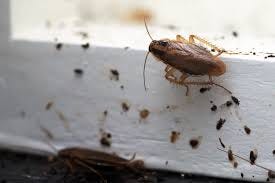What Do Baby Cockroaches Look Like?
Baby cockroaches, also known as nymphs, hatch from oothecae (egg cases) and actively seek food and shelter from the moment they emerge.
Size: Typically about ⅛ to ¼ inch long, depending on the species (e.g., German vs. American roaches).
Color: Start light (whitish or pale), then darken with each molt.
Shape & Features: Flat, oval bodies without wings.
They are very fast movers and prefer to stay hidden in dark, moist areas. Unlike adults, they lack fully developed wings and cannot fly. Baby cockroaches molt several times as they grow, shedding their exoskeleton after each stage. Spotting even a few nymphs can be an early sign of a larger infestation developing nearby.

German cockroach infestation with droppings on window frame
Cockroach Life Cycle
Cockroaches grow through incomplete metamorphosis, meaning:
Egg Stage — inside protective cases called oothecae.
Nymph Stage — baby cockroaches molt 5–10 times as they grow.
Adult Stage — fully developed with wings and reproductive ability.
Even a single nymph signals that adults are nearby and breeding — action should be taken immediately.
Infestation Warning Signs
Spotting baby cockroaches? That likely means a bigger infestation. Look for:
l Droppings: Small black specks in cabinets or corners.
l Shed Skins: Nymph exoskeletons under sinks or behind appliances.
l Egg Cases (Oothecae): Brown, purse-shaped capsules.
l Musty Odor: Strong smell caused by pheromones.
l Daytime Sightings: Roaches are nocturnal — seeing them in daylight signals overcrowding.
Health Risks of Baby Cockroaches
Baby cockroaches aren’t just unsettling — they can harm your health:
l Bacteria Spread: Known to carry Salmonella and E. coli (source: Your Pet Planet).
l Allergic Reactions & Asthma: Cockroach allergens can worsen respiratory issues.
l Food Contamination: They crawl across food prep areas, spreading germs.
Effective Removal Steps
Seal Entry Points — block cracks, repair screens, seal crevices.
Remove Food & Water Sources — airtight containers, fix leaks, wipe spills.
Use Traps & Baits — sticky traps and poisoned baits target colonies.
Natural Remedies:
Diatomaceous Earth — dries out roaches.
Boric Acid — highly effective but must be used carefully.
Hire Professionals — pest control services handle severe infestations.
Preventing Future Infestations
Keep kitchens and bathrooms clean & dry. Take out trash regularly. Store food (including pet food) in sealed containers.
Reduce clutter and hiding spots.
FAQs About Baby Cockroaches
Q1. Does spotting a baby cockroach mean I have an infestation?
Yes — seeing one usually indicates adults are present and breeding.
Q2. Can baby cockroaches fly?
No. Only adults have wings.
Q3. How long does it take for a baby cockroach to become an adult?
Depending on species, 2 months to over a year (Your Pet Planet).
Q4. Are baby cockroaches a health hazard?
Yes — they spread bacteria and trigger allergies, just like adults (CDC Pest Control).
Q5. What’s the fastest way to eliminate baby cockroaches?
Use bait stations or boric acid along with sealing entry points.
Final Thoughts
Don’t underestimate baby cockroaches — they’re a clear warning sign of infestation. By sealing entry points, keeping your home clean, using effective traps, and seeking professional help if necessary, you can stop these pests before they grow into a major problem.
For more detailed insights, check out 15 Surprising Baby Cockroach Facts Every Homeowner Should Know on Your Pet Planet.




Comments